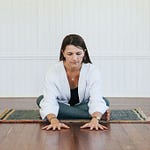(Please read the description below before listening to the breathwork practice)
image found here via Pinterest
It’s incredible that we hold past emotions in our bodies isn’t it? The amazing book The Body Keeps the Score by Dr Bessel van der Kolk explains this in huge detail. The book is quite confronting and (for me!) not easy to read but shows how extreme trauma is stored physically in the body.
For most of us who haven’t necessarily experienced intense trauma like the examples in the book, we all have been through events in our lives where we repressed the emotions we were truly feeling.
This week I’m sharing a breathwork meditation that helps to release the repressed emotions from the fascia. It’s known as a two part breath because the inhale is taken in two parts, the first is low in the diaphragm so the belly expands and the second part is in the top of the diaphragm making the chest expand. It is also practiced with an open mouth which means it feels more powerful than a calming nasal breath.
This one is a little different to some of the other breathwork practices I’ve shared. While they can have a meditative effect on the body and mind, they are usually designed to calm the nervous system due to breathing more slowly and using the nose, or correct how we breath (by improving the functioning of the lungs for example). These practices are transformative as they can improve how we feel physically due to a breathing well, improved digestion, ability to feel more empathy and think more creatively as well as reducing anxiety and stress - definitely life changing effects!
However, the two part breath I’m sharing today is when the practitioner enters into a deeper meditation. This practice is using the breath to quickly get out of the head and into the body to feel whatever emotions we have stored in the fascia.
What is happening in the body during this two part breath?
Oxygen enters the blood stream through the lungs and moves to the hypothalamus gland (known as the crown chakra in yoga). This gland releases endorphins that flow to the other ductless glands (the other chakras). As your energy starts to move your emotions may start to move too.
As you continue to breath in the pattern you may start to feel emotions surfacing. The idea is keep breathing and allow the emotions to come up and out. In this practice we don’t need to use the mind to attach any meaning to the emotions, instead we need fully experience them and let them pass. At the end of the breathing practice it’s important to lay still in savasana for a few minutes.
How to take the breath work practice
Lie down flat on the floor with a yoga mat or rug under you. You might like to have a bolster or rolled blanket under your knees.
Make sure your throat is open. For most of us this means lying without a pillow. However you may need a folded blanket under your head if your chin is higher that your forehead.
I like to move the body first for a few minutes to release some tension and make it easier to lie still. However you can go straight into the breathing.
Make sure you have privacy and feel safe where you are. Have some blankets nearby in case you get cold after the breathing.
If you like to add music to your practices then you can listen to this Spotify playlist as a suggestion. If you don’t have a paid subscription I don’t suggest it as there will be ads that will distract you.
You might like to have a journal to make some notes about your experience. Up to you if this is something that might feel helpful.
Some important things to remember:
You are not hyperventilating. This is an active meditation that is continuous with a steady rhythm.
Never take any kind of breathwork practice while driving or swimming.
You may feel a tingly sensation in the body - possibly around the mouth or the hands. This is normal and will go away once you breathe slowly and calmly through the nose at the end of the practice.
In this practice you are in control. It is important to know that you are the breather and you’re consciously taking control of the breath. Nothing is happening to you, but you are taking an active meditation. You can stop and breathe through your nose at any time.
You may not feel any emotion at all and that is okay. Your mind might be holding on tightly.
If you have experienced trauma in your life then please take this alongside a professional therapist. If the emotions feel too much for you to handle alone please seek professional help.
Likewise for any other other health condition. Please check with your doctor if breathwork is suitable for you.
Alright! You can go ahead, set yourself up and experience this breathwork practice. I’d love to know how you go. Please do let me know.
Love Sarah
Thank you for reading! I am always very grateful.
I’d love you pass this on to someone who might enjoy it.
Here are some ways we can connect:
Spring yoga weekend in Yamba. 30th September and 1st October. Learn more here
Start your free 14 trial of my online yoga membership Move, Breathe, Rest.
I love to get emails from readers. Please reply with any comments or questions.














This breathwork practice was my deepest meditation yet.